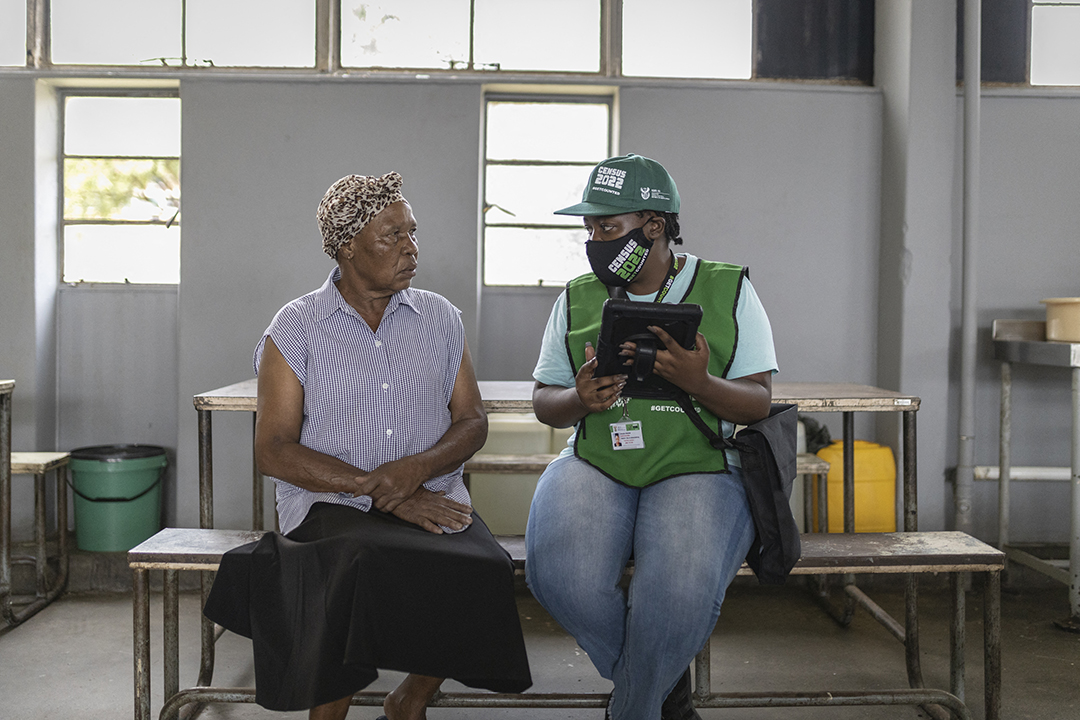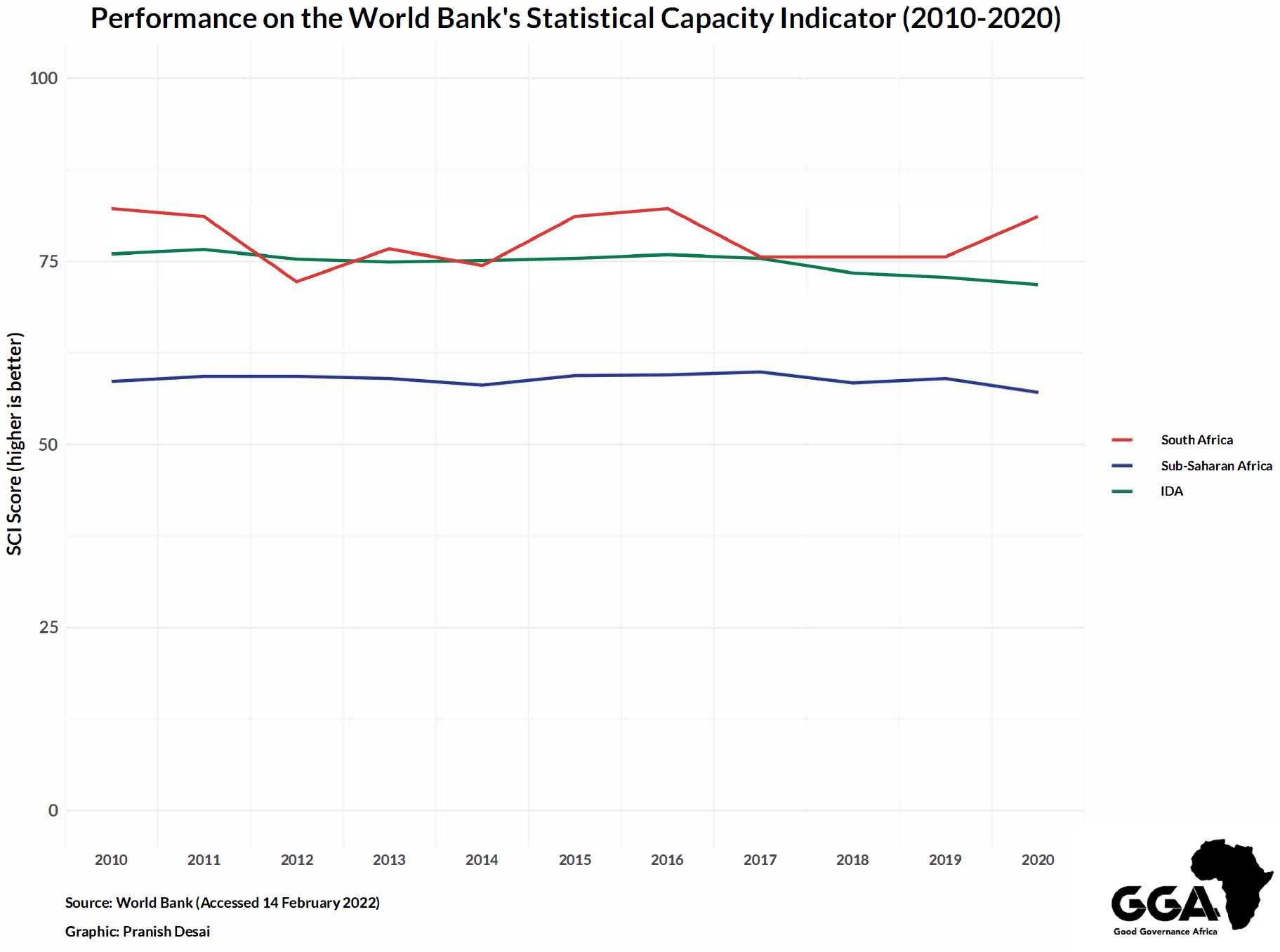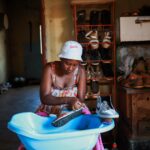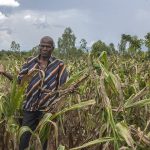
A census field officer speaks with a woman who lives at the Helen Joseph Women’s Hostel in Alexandra Township on February 17, 2022. Photo: Guillem Sartorio/AFP
The fourth national census in South Africa’s democratic history commenced on 2 February 2022. For the first time, and partly as a response to the complications arising from the COVID-19 pandemic, the 2022 census contains a large-scale online component, with South African residents having the option to register online and complete the census questionnaire remotely without the presence of a fieldworker.
The census provides an aggregate count of all persons living within South Africa’s borders, regardless of age, location, and nationality. The questionnaire also collects essential information about income levels, living conditions, age profiles, and the access which people have to critical basic services such as water, electricity, and functioning sewerage systems. The information collected during this process plays a crucial role in planning at the national, provincial, and municipal levels, by providing policymakers with the information required to formulate rational policies and implement service delivery, build and maintain critical infrastructure such as hospitals and schools, and determine budgetary allocations for various spheres of government.
The South African statistical community
South Africa has one of the best statistical capacities and data collection infrastructures of any developing nation. The cornerstone of this capacity is Statistics South Africa. Although the existence of a national statistical office within South Africa predates democratisation, the origin and mandate of the contemporary institution is derived from the Statistics Act (Act 6 of 1999). This legislation tasks the organisation with collecting, producing and disseminating official statistics including periodic national population censuses. The Act also established a Statistics Council comprised of persons representing a variety of interests within South Africa’s statistical community.
Since 1994, South Africa has had three full population censuses, in 1996, 2001 and 2011. Beyond this, Statistics South Africa also collects data and produces vital publications such as quarterly employment statistics, quarterly financial statistics, industry breakdowns and mid-year population estimates. These publications provide valuable insight for entities such as government departments, international organisations, researchers, universities and the private sector. The chart below visualises the mid-year population estimates produced annually for the period from 1994 to 2021, with South Africa’s total population rising from 38.63 million to 60.14 million in this time.

A story of stagnation: statistical capacities in Africa
However, the quality of South Africa’s data infrastructure and statistical capacity is very much the exception and not the norm on the African continent. This is partially a consequence of the relationship between better governance, economic development and improving statistical capacity. Countries such as Egypt, South Africa and Mauritius, which are better resourced and have reached greater levels of economic development than many of their counterparts, have superior data infrastructures and statistical capacities.
By contrast, African countries with weaker state capacity and fewer resources, such as Eritrea and the Republic of the Congo, have inferior data infrastructures and statistical capacity. States like Somalia will have a limited capacity to improve their statistical capacity as long as they continue to be plagued by fragility, which makes ground-level data collection itself challenging, due to the risk posed to the lives and wellbeing of data collectors themselves.
And yet, despite not all African countries having problems to this extent, statistical capacities across the continent have stagnated over the last decade. The figure below displays the performance of countries in Sub-Saharan Africa for the period between 2010 and 2020, according to the World Bank Statistical Capacity Indicator.

As the visualisation shows, statistical capacity in the region has seen little improvement over this period, rating consistently worse than other countries classified as “developing”, according to the International Development Association (IDA). African countries, on average, need to improve from a lower base capacity compared to other developing regions such as Southeast Asia and South America. Thus, their stagnation is of paramount concern in a world where data is playing an increasingly prominent role in issues of commerce, conflict, development, education, governance and health.
The COVID-19 pandemic exposed the necessity of critical data infrastructures and improving statistical capacities. Access to reliable data has been essential in helping countries to monitor infection, hospitalisation and death rates, determine the virulence of variants through statistical sampling and modelling, as well as in using location-based data to distribute critical medical equipment such as therapeutics, vaccines and ventilators to areas which require them.
However, our ability to understand the full consequences of the virus in African countries is incomplete because of this stagnant capacity. For instance, the lack of reliable death registration systems in many African countries is one of the clearest ways in which this dearth of information has affected our understanding of the consequences of the pandemic, since there is minimal information on pivotal indicators such as “excess deaths”. To help improve the statistical capacity to collect and analyse these vital statistics across the continent, statistical communities which have these resources and competencies should play a more active role.
South Africa’s role in capacity building
The South African statistical community has displayed initiative in this regard, primarily through the ISIbalo Capacity Building Programme. Statistics South Africa launched the programme in 2009 to coincide with South Africa’s hosting of the 57th Session of the International Statistical Institute (ISI) Congress. ISIbalo had five main initiatives:
- the development of Africa’s statistical research and capacity;
- the establishment of a research programme for young statisticians in Africa;
- the encouragement of young girls’ participation with regards to education in mathematics and statistics;
- the formulation of an international statistical education programme
- and an African Women in Statistics initiative designed to foster the involvement of women professionals within the formal statistics community in Africa.
For much of the 2010s, Statistics South Africa, through ISIbalo, played a prominent role in improving critical data infrastructures and statistical capacities on the continent, by being the primary funders of events such as the Young African Statisticians Conference. However, by 2018, the initiative was facing substantial spending cuts due to austerity measures imposed on Statistics South Africa, which required the institution to divert spending away from its capacity building initiatives on the continent to other priorities. As a result, ISIbalo initiatives such as the Young African Statisticians Conference have had to look elsewhere for continued funding, a task especially challenging in the aftermath of the impact that the COVID-19 pandemic has had on public and private finances.
Not only has the statistical capacity of many African countries continued to stagnate over the past decade, but one of the few well-resourced statistical communities is now playing less of a role in helping build capacities in the rest of the continent. To improve on these trends, it is essential that the South African Government adequately funds vital institutions such as Statistics South Africa, thereby allowing them to revive and expand their efforts to bolster data infrastructures and statistical capacities in the rest of Africa.
At a basic level, this funding needs to adequate enough to build sufficient capacity in the ISIbalo programme and the five core initiatives it outlined. And while these initiatives will go a long way to improving statistical literacy on the continent, areas of statistical innovation also require greater investment. This is particularly important when dealing with geospatial data, which is playing an increasingly prominent role in policymaking in both developed and developing countries.
Such collaborative approaches will not only improve statistical capacity and innovation on the continent, as well as enhance South Africa’s reputation with other African countries, but will also help realise South Africa’s aspirations of facilitating African development and increasing regional cooperation. One signal of intent which the South African government can use to confirm its serious commitment to improving statistical capacity on the continent is to complete the ratification process required for signing onto the African Charter on Statistics. Despite continued advocacy by Statistics South Africa, this process has proceeded too slowly since the charter received initial cabinet approval in September 2015.
The Way Forward
South Africa’s ability to administer its census in the midst of the COVID-19 pandemic further cements its statistical community’s reputation as being at the forefront of the developing world. However, to help reverse the continental trends of capacity stagnation, South Africa needs to play a greater role in building statistical capacity across the continent. This can be done by reviving and properly funding initiatives such as the ISIbalo Capacity Building Programme, and also by providing greater investment in helping the continent keep track of data innovations in areas such as geospatial data. The first way in which the South African government can provide a strong signal of the intent to help improve the state of statistical capacity on the continent, is to streamline the ratification process for South Africa’s inclusion within the African Charter on Statistics.
This article first appeared in the Mail & Guardian.
[activecampaign form=1]
Pranish Desai is a doctoral student in political science at the Massachusetts Institute of Technology. His core areas of focus are in comparative politics and political methodology, with a specific interest in the politics of Southern Africa. Between 2021 and 2024, Pranish held several key positions within the Governance Insights and Analytics programme at GGA. In these roles, he was centrally responsible for the elevation and enhancement of the Governance Performance Index as GGA's flagship governance assessment tool. Before departing GGA, Pranish also played a key role in the development of our strategic framework for the 2024-2028 period.













